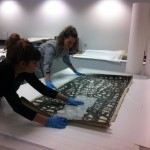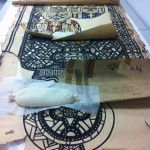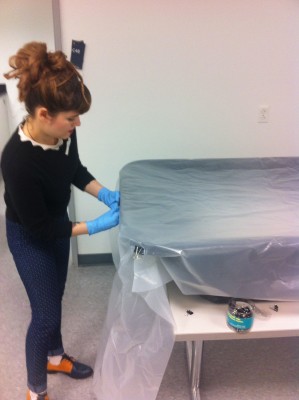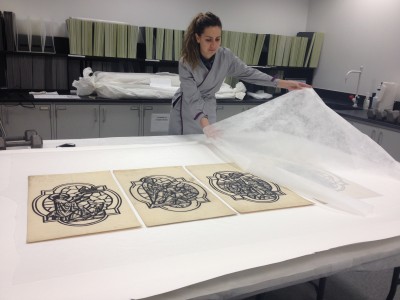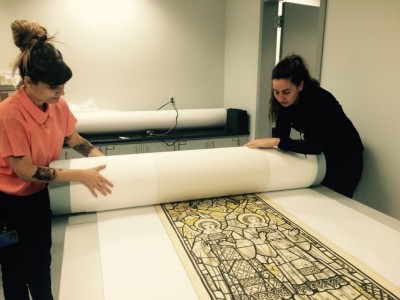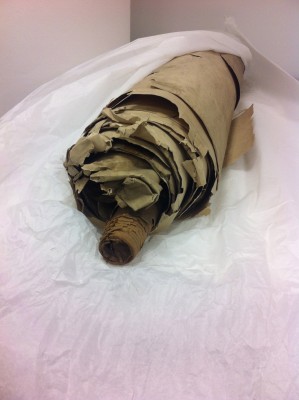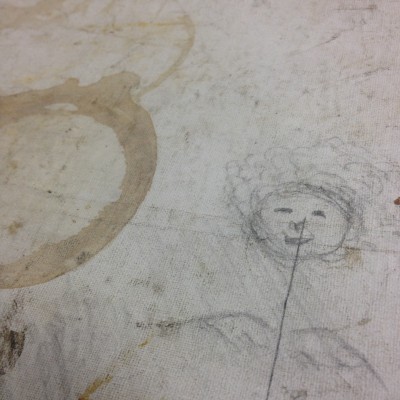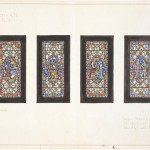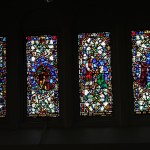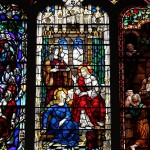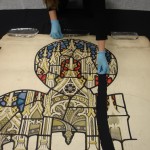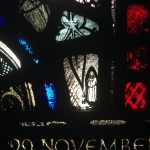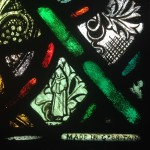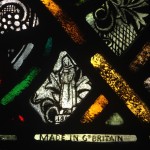This post comes from Nicole Monjeau and Natasa Krsmanovic, Rakow Library interns who worked on conserving the Whitefriars cartoon collection over the summer. Read more about this project in previous posts.
This summer, we are working on the conservation treatment of the Rakow Library’s Whitefriars collection of oversized stained glass cartoons, a project made possible in part by the Institute of Museum and Library Services. This is a joint internship between the Rakow Library and West Lake Conservators. The collection contains 1,800 rolls, each roll containing multiple objects. Collectively, the individual cartoons number in the thousands.
The first set of rolls we treated this summer were from St. Stephen’s Church, Olean, NY. The rolls contained a variety of paper objects, including machine-made paper, tracing paper, kraft paper, waxed canvases, and photographs. Some of the cartoons were executed in detail, with watercolor, graphite, and charcoal, while others were simple outlines in ink-wash.
- Here we are inspecting a Whitefriars photograph: Nicole Monjeau (L) and Natasa Krsmanovic (R).
- St. Stephen’s Church, Olean, cartoons being unrolled for the first time.
The goal of the conservation project was to stabilize the rolled material for digitization and storage. The treatment involved surface cleaning, and humidifying the rolled objects, so they could be safely unrolled and flattened. Objects with tears that raised handling concerns were mended. Once objects were fully treated, they were placed in flat file storage. Objects too big for flat files were rolled onto 10” archival cores and placed in boxes.
- Nicole preparing the humidification chamber.
- Natasa inspects the cartoons after they have been fully treated.
- Nicole and Natasa roll a conserved cartoon onto a large core for storage.
The most exciting part about working on this project was unrolling the objects for the first time. We did not know what we were going to find until we looked at the objects in each roll. We enjoyed looking closely at the objects, many including surprises, such as small notes, sketches, and doodles in the margins. Tea-ring stains and newspaper clippings found lodged between pasted photographs give a sense of the working environment, and how these cartoons were handled.
- An unopened roll of cartoons of St. Stephen’s Church, Olean NY.
- A detail of a tea ring stain and doodle on a waxed canvas.
The Whitefriars cartoon collection was a gift from the Museum of London in 2008. One of the exciting aspects of this project was the collaboration between the MOL and CMoG. Many of the Whitefrairs presentation drawings are in the MOL’s collection. The MOL has shared some of their presentation drawings of St. Stephen’s Church in Olean. It was great to compare the original drawings to the final stained glass windows.
- Museum of London presentation drawing
- St. Stephen’s Church, Whitefriars stained glass windows
Early in July we had an opportunity to visit St. Stephen’s Church to see the windows in person. It was great to see the final product after working so closely with the preparatory materials. Standing before the actual glass, we could truly appreciate how the Whitefriars designers considered light and color. When preparing the presentation drawings and cartoons, the application of watercolors and other mediums appear to mimic the transparency and effects of light seen through the ornate pieces of glass. This clearly shows a well-thought out process, and a sense of the artist’s intent.
- Admiring the outside of St. Stephen’s Church during our site visit.
- A Whitefrairs stained glass window in St. Stephen’s Church, Olean.
- A cartoon with watercolor depicting the outer design of the stained glass window.
One fun aspect of the trip was looking for the elusive Whitefriars monk, which was an identifier for the company. We were unable to find any monks while working on the cartoons. However, it didn’t take long to find them within the actual stained glass installations. It was great to see this marker of the Whitefriars company.
- A Whitefriars monk.
- A Whitefriars monk.
- A Whitefriars monk.
We have been carrying out conservation treatment on multiple rolls, representing a wide variety of geographic locations. We look forward to seeing these objects digitized and publicly accessible. Dynamic and international in scope, the Whitefriars collection at CMoG is a great example of how the preservation and study of archival material can teach the world about glass. With so many rolls in the collection, the potential for discovery is endless.
Catch up on the progress of the Whitefriars project.
This project was made possible in part by the Institute of Museum and Library Services (#LG-55-14-0110-14).
The Rakow Research Library is open to the public 9am to 5pm every day. We encourage everyone to explore our collections in person or online. If you have questions or need help with your research, please use our Ask a Glass Question service.

